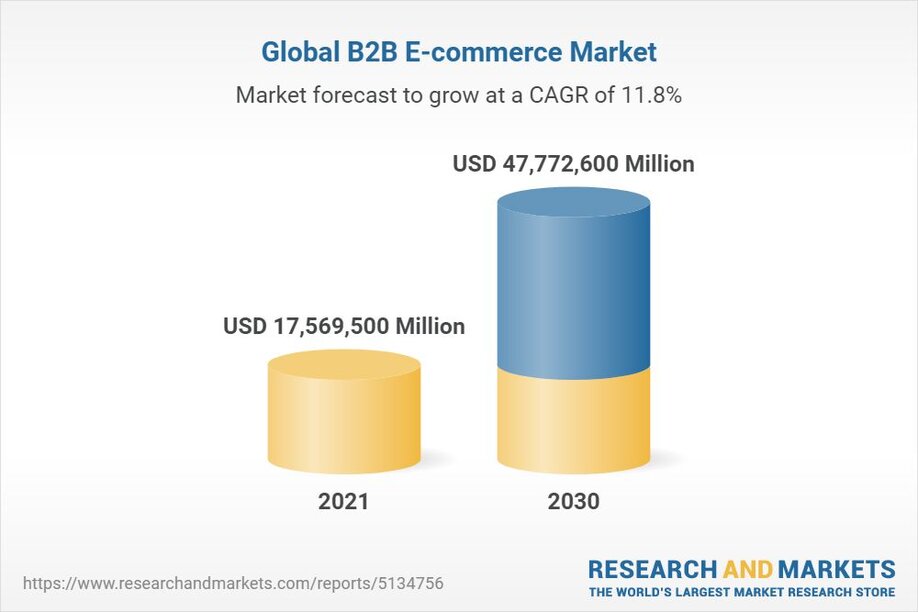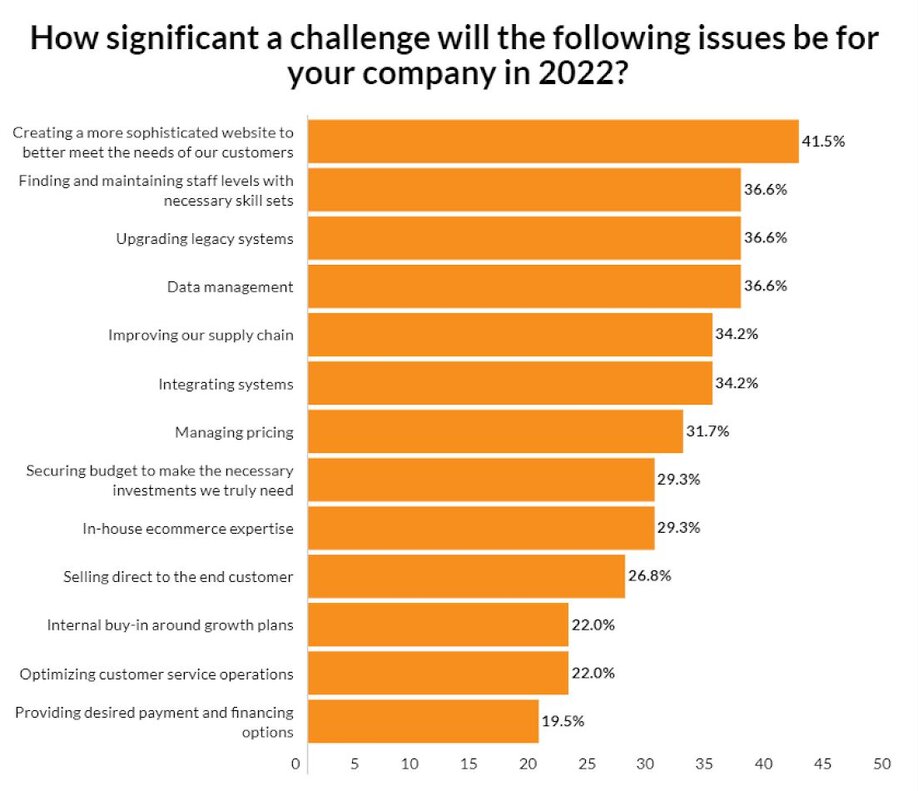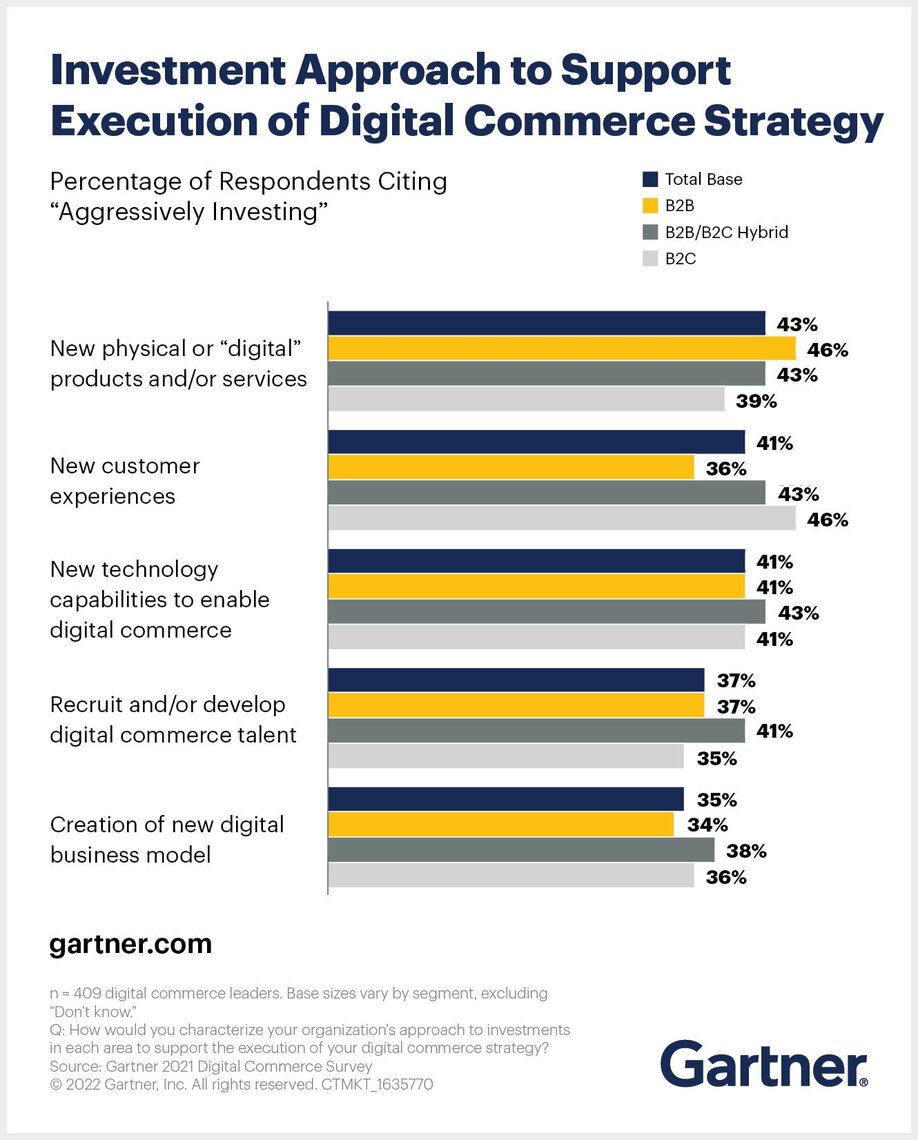Blog post
Expert advice
🕒 12 min
Technical Aspects to Look Out for when Adopting Digital Commerce Solutions
Integrating a digital commerce platform is just the start—businesses have to seamlessly blend it into the existing workflow—prioritizing scalability, integrations, and data management

Operational challenges are the top concern
Recent research showed that the B2B eCommerce market can reach USD 26.59 trillion by 2030 globally. Despite the economic shockwaves incurred by the global unrest, 65% of B2B companies across industries ventured towards eCommerce in 2022. This marked a significant contrast to the start of 2020 when 60% of companies had no digital capabilities whatsoever.

The global B2B eCommerce market forecast 2021–2030 (image credit)
B2B players recognize that simply creating a self-service portal might not be enough and are ready to embark on a steep learning curve in digital transformation. But the steadfast eCommerce adoption does not always lead to exceptional customer experiences head-on. With 67% of B2B buyers shopping online, approximately 66% of them are dissatisfied with the journey. As of 2021, 89% of UK and US companies found purchasing online more complex than using traditional offline methods.
In response, sellers have to undergo comprehensive changes across various business areas: developing new eCommerce strategies, transforming the IT infrastructure, and fostering the right tech culture in-house. The combination of those measures can bring the most desired outcome—efficient back-office operations and better customer outcomes. So pivoting towards modern eCommerce platforms with mature, yet agile functionality can help streamline operations, enhance customer experiences, and drive sustainable growth.
In this article, we look into a B2B eCommerce solution demo built on top of Sitecore OrderCloud. The demo showcases the platform's capabilities against various scenarios and exemplifies how to address some common challenges B2B companies face.
Things to consider before eCommerce adoption
It may seem pretty easy for businesses to get online—just choose a SaaS provider or set up a cloud infrastructure. The challenges come afterward when they deal with scalability, integrations, and customer experience optimization. The ability to address Day 0 and Day 1 issues lays the foundation for smooth eCommerce adoption.
Legacy system upgrades
Many companies still invest heavily in maintaining legacy systems just to keep things running. This leads to increased technical debt that uproots investments in piloting new strategies and business models.
Data management
In traditional settings, data is scattered across systems or stored in an on-premises infrastructure, which limits scalability and visibility into customer information and back-office operations. So implementing modernized architectures can reduce the time and money spent on related manual processes.
Integrations
Integrations with the existing systems allow for data synchronization across mission-critical systems, such as ERP, CRM, order/inventory management software, marketing tools, etc. As a result, organizations can have a unified view of data and streamline operations. But sometimes compatibility issues and poor data quality undermine smooth data transition, making the integration process yet another headache.

eCommerce challenges of B2B wholesalers and distributors (image credit)
Catalog management
Accurate and organized product information (pricing, descriptions with no duplicates, proper labels) can help sail through both inventory operations and customer experience. Still, the time-consuming filling of product info, inaccurate data across channels, and scalability issues can be top concerns.
Order management
Companies can choose either from a platform with its own order management tool or third-party software. Although some third-party systems offer unique features and flexibility, their implementation can come with technical complexities. The lack of sufficient support can also prevent timely troubleshooting and updates. With this in mind, going with an eCommerce vendor can be a reasonable choice in certain cases.
Payment processing
Payment processing involves integration with multiple payment gateways. Securing transactions and ensuring compliance with industry standards is crucial to protect sensitive data.
Customization and personalization
73% of buyers—including the B2B sector—expect sellers to anticipate their purchasing behavior. Today’s digital commerce solutions aim to satisfy these expectations, providing the tooling for personalization across all stages of the eCommerce process.
Let’s explore how technology solutions can address the concerns raised above.
Invest smartly: a robust solution to solve Day 2 tasks
Modern technology can be the key when utilized right. Equipped with knowledge, resources, and support, companies can effectively navigate the complexity and make it work for their business.
Here, we will showcase the solution, a B2B eCommerce accelerator, custom-built on top of Sitecore OrderCloud. Mikhail Ulasevich, Lead Front-End Developer, and Aliaksei Turchinovich, eCommerce Solutions Architect, share their thoughts on how such a system can address specific tasks.
Ensuring scalability, performance, and ease of maintenance
The system comprises 3 core components: an OrderCloud API, a storefront, and an admin panel. The OrderCloud API serves as a foundation for catalog, pricing, inventory, and fulfillment management. It also handles the centralized storage and retrieval of critical data and provides means for ensuring security and compliance. The admin panel is designed to perform back-office operations, helping administrators to update products, oversee the ordering process, and manage customer accounts. The storefront provides a user-friendly interface, enabling customers to interact with the solution, performing a range of tasks: account creation and authentication, cart management and checkout, etc.
Composable commerce lies at the core of the solution. It allows to break the system down into modular, easily reusable components that are easy to maintain, integrate, and extend with new functionality. Businesses can reap a bunch of benefits, such as agility, quick demand adaptability, and reduced costs on associated tasks.

“Solutions built with composable commerce as a foundation let companies create highly personalized and customized experiences. Meanwhile, you deliver those experiences almost effortlessly, since you can easily assemble and reassemble different system parts, scale horizontally, load balance resources, and integrate new tech without any vendor lock-in. In other words, you invest smartly and, as a result, future-proof your business, which is the primary objective.”

The architecture of the B2B eCommerce accelerator by Amitech Group

“The solution’s multilayer architecture combines the best of two popular approaches in building eCommerce applications: MACH and monolith architecture. This enables us to develop fast, scalable, secure, and customizable solutions that are easy to support and maintain. By incorporating this approach, we make sure that our technology stack remains both forward-looking and relevant in the ever-evolving eCommerce landscape.”

In addition, Next.js offers built-in optimizations, such as static site generation, server-side rendering, and incremental static regeneration. This allows to create SEO-optimized and highly performant web apps for eCommerce projects of various complexity.
Facilitating integrations and data management
To keep things smooth, it is better to stick to a consistent data format across all integrated systems, as it saves time spent on troubleshooting. Another big thing to do is to avoid duplicates and data loss. For the purpose, we automate data mapping between the systems and ensure it is accurately transformed. By validating incoming data, we achieve its accuracy and integrity. It is also crucial to have robust logging and error-handling mechanisms in place to handle integration issues effectively. Regular data backups and a recovery strategy help to mitigate accidental data loss in case of system failures.
Tightening up security and compliance
Sitecore OrderCloud leverages OAuth2, a widely adopted security industry standard for permission-based apps. In addition, the platform supports OpenID Connect enabling seamless single-sign-on functionality. Talking about compliance, Sitecore OrderCloud already conforms with such industry standards as General Data Protection Regulation, California Consumer Privacy Act, and Payment Card Industry Data Security Standard.
Enabling B2B commerce functionality
The B2B accelerator features both buyer management and commerce management capabilities. It supports integrations with ERP, CRM, or PIM systems, serving as the existing digital sources of truth for orders, products, and payments.
The solution also offers pre-built integrations with tax management tools (TaxJar and Avalara) to simplify tax calculations, automate tax compliance, and ensure accurate taxation for B2B transactions. In addition, the accelerator seamlessly integrates with popular shipping providers (FedEx and UPS) to track deliveries, generate shipping labels, and provide real-time shipping rates to customers. Any custom integrations of choice are also available.
Improving user experience
While building the user interface of the solution, we opted for a component-based approach in Next.js. The approach streamlines the UI development process, enhances code reusability, promotes consistency, and creates scalable and maintainable user interfaces.
To further enhance customization and personalization, we used Tailwind CSS. Relying on the utility-first approach, the framework allows us to easily adapt the UI to specific design requirements, improving maintainability, development speed, and performance. Tailwind CSS is also a great choice for constructing responsive interfaces catering to diverse devices and screen sizes. This level of customization helps create experiences that align perfectly with a brand identity and user goals.
Additionally, the storefront supports multiple search options including both out-of-the-box search and Sitecore Discover search. The functionality includes faceted search, keyword search, wildcard search, synonyms, and word stemming. This enables users to find relevant results faster. With intelligent ranking, wildcard filtering, widgets, and content suggestions, the storefront provides a seamless and personalized browsing experience.
Driving content management
The accelerator features compatibility with content management systems like Strapi CMS and Sitecore XM Cloud. Businesses can operate content at scale, while ensuring flexibility as well as a high level of customization and personalization.
By utilizing multiple inbuilt components and plugins, it is possible to organize and manipulate different types of content, making it easy to navigate and comprehend. With multilingual capabilities, companies ensure they convey consistent and accurate brand messaging in multiple languages to reach a broader audience.
Market predictions
According to a survey by Gartner, 86% of B2B and B2C leaders choose digital commerce as the most important route to invest in the next few years. To market the eCommerce strategy effectively, these are the trends to follow.
Increasing digital maturity. Research says that B2B organizations are lagging in digital adoption—compared to B2C companies—lacking the talent and resources to drive transformation. To improve this, businesses have to establish the test and learn culture in-house, promoting innovation and encouraging experiments—all backed up with relevant expertise.

Investment approaches to drive eCommerce adoption (image credit)
Diversifying tactics and investing. The balance between short-term and long-term strategies relies on the level of digital commerce maturity. Less mature organizations may prioritize short-term tactics to demonstrate their potential and achieve improved performance, securing additional investments. Meanwhile, advanced organizations can strategically select opportunities and invest for future growth.
As we navigate the digital era, businesses recognize the need to evolve, follow market trends, and adapt their strategies accordingly. Collaboration between stakeholders, knowledge sharing, comprehensive guidance, a detailed eCommerce plan, and risk assessment can help overcome the challenges and pave the way for unlocking opportunities.
Last updated: May 31, 2023
About the authors

Drives the team’s technical excellence like there are no barriers. Gears the race with real game-changing finds.

Does the whole back-to-front heavy-lifting and juggles tormented challenges with eye-opening maneuverability, as hard work looks good on him.

Adept at crafting engaging and user-friendly copy about software technology, cloud computing, and eCommerce development.
Keep track on latest trends in web
Let’s nail another market-shaking project together! While you are thinking, check out our latest ones.


